
8 minute read
The Scientific Journey of
from FlowOx Brochure
by DMedical
FlowOx™
For a complete overview of all pubications please refer to page 35.
Advertisement
2016
STUDY
Application of intermittent negative pressure on the lower extremity and its effect on macro- and microcirculation in the foot of healthy volunteers.
Author: Sundby et. al. 2016.
2019
STUDY
The acute effects of lower limb intermittent negative pressure on foot macro-and microcirculation in patients with peripheral arterial disease.
Author: Hoel et. al. 2019.
2020
STUDY
Treament with intermittent negative pressure (INP) for intermittent claudication
(Impact on primary clinical endpoints)
A Randomized Controlled Trial (RCT)
Author: Hoel et. al. 2020.
2021
STUDY
Effects of intermittent negative pressure treatment on circulating vascular biomarkers in patients with intermittent claudication Biomarkers.
Author: Hoel et al. submitted 2021.
1934
STUDY
The idea of "Intermittent Negative Pressure" was first conceived in the 1930’s by Herman and Reid.
2010 Development of the FlowOx™ Concept in Norway.
2017
STUDY
The acute effects of lower limb intermittent negative pressure on foot macro- and microcirculation in patients with peripheral arterial disease.
2019
STUDY
Fluctuation in shear rate, with unaltered mean shear rate improves brachial artery flow-mediated dilation in healthy, young men.
2021
STUDY
Follow-up trial: Walking distance after 24 weeks. Treatment with intermittent negative pressure (INP) for intermittent claudication (IC)
(Impact on primary clinical endpoints)
12 week follow up trial.
2021
STUDY
Economic model to examine the cost-effectiveness of FlowOx home therapy compared to standard care in patients with peripheral artery disease.
Hermann and Reid; Arch Surg. 1934;29(5):697-704

Author: Sundby et. al. 2016.
Author: Holder et. al. 2019.
Author: Hoel et al. submitted 2021.
Author: Ezeofor et al., 2021.
Studies on the Acute Effect Of INP Therapy on Blood Flow Parameters
CLINICAL DATA AND EVIDENCE
Over the past few years, INP Therapy has gained significant attention for its potential to improve cardiovascular health The following studies from 2016, 2017, and 2019 focus on the acute effect of INP therapy on blood flow parameters.
The effects of FlowOx™ and Intermittent Negative Pressure (INP) are based on basic physical principles and have been well-researched and documented in clinical studies.
These studies have been done on both healthy individuals and PAD patients
Both results have shown positive effects of FlowOx™.
Results from studies focused on determining the optimal pressure level that would achieve the desired result without causing unnecessary pain or stress to the patient.

Study
2016
Application of intermittent negative pressure on the lower extremity and its effect macroand microcirculation in the foot of healthy volunteers.
Author: Sundby et. al. 2016.
Study Conclusion
This study found that application of frequent mild intermittent negative pressure (INP) of -40 mmHg in the foot in healthy volunteers induced rhythmical fluctuations in blood flow and increased both arterial blood flow velocity and skin blood flow.
This was the first study to describe the effects of INP on skin blood flow and arterial blood flow velocity. The first to compare different sequences of negative pressure oscillations on lower limb perfusion.
2017
The acute effects of lower limb intermittent negative pressure on foot macro- and microcirculation in patients with peripheral arterial disease
Author: Sundby et. al. 2016.
2019
The acute effects of different levels of intermittent negative pressure on peripheral circulation in patients with peripheral artery diesase.
The study found that INP increases foot macro- and microcirculatory flow pulsatility. Application of INP resulted in increased mean arterial blood flow velocity.
The study found that INP of -40 and -60 mmHg applied in cycles of 10 sec of negative pressure and 7 sec of atmospheric pressure induced acute increase in arterial and skin blood flow.
The FlowOx™ treatment is suitable for patients who are struggling with ischemic wounds, painful walking, painful resting and painful, slow recovery from surgical revascularization.
Read the complete studies at www.flowox.com
Author: Hoel et. al. 2019.
2019
Fluctuation in shear rate, with unaltered mean shear rate, improves brachial artery flow-mediated dilation in healthy, young men.
Author: Holder et. al. 2019.
The study found that INP induces fluctuations in blood flow and shear rate that improves endothelial function. This may represent a hemodynamic stimulus improving vascular health.
The Holder et al study started to shed light on the longer term mechanism of action for FlowOx™.
Blood Flow Parameters with INP Mechanism of Action with FlowOx™
EVIDENCE
When applying INP in combination with FlowOx™, the level of impact is visible in the skin blood flow and the fluctations in the arterial flow.
These blood flow parameters show the differences in the arteries and veins during the active phase as opposed to the passive phase.
Increased fluctuations in skin blood flow
The pictures on the right show the laser speckle imaging of the skin during FlowOx™ treatment. The active phase photo shows a bright blue color which indicates the increased skin perfusion.
PASSIVE PHASE ACTIVE PHASE
FlowOx™ Therapy affects the baseline sequence
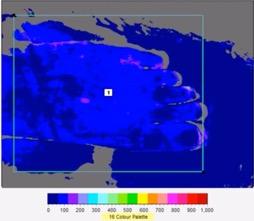
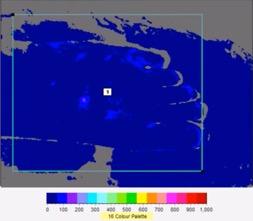
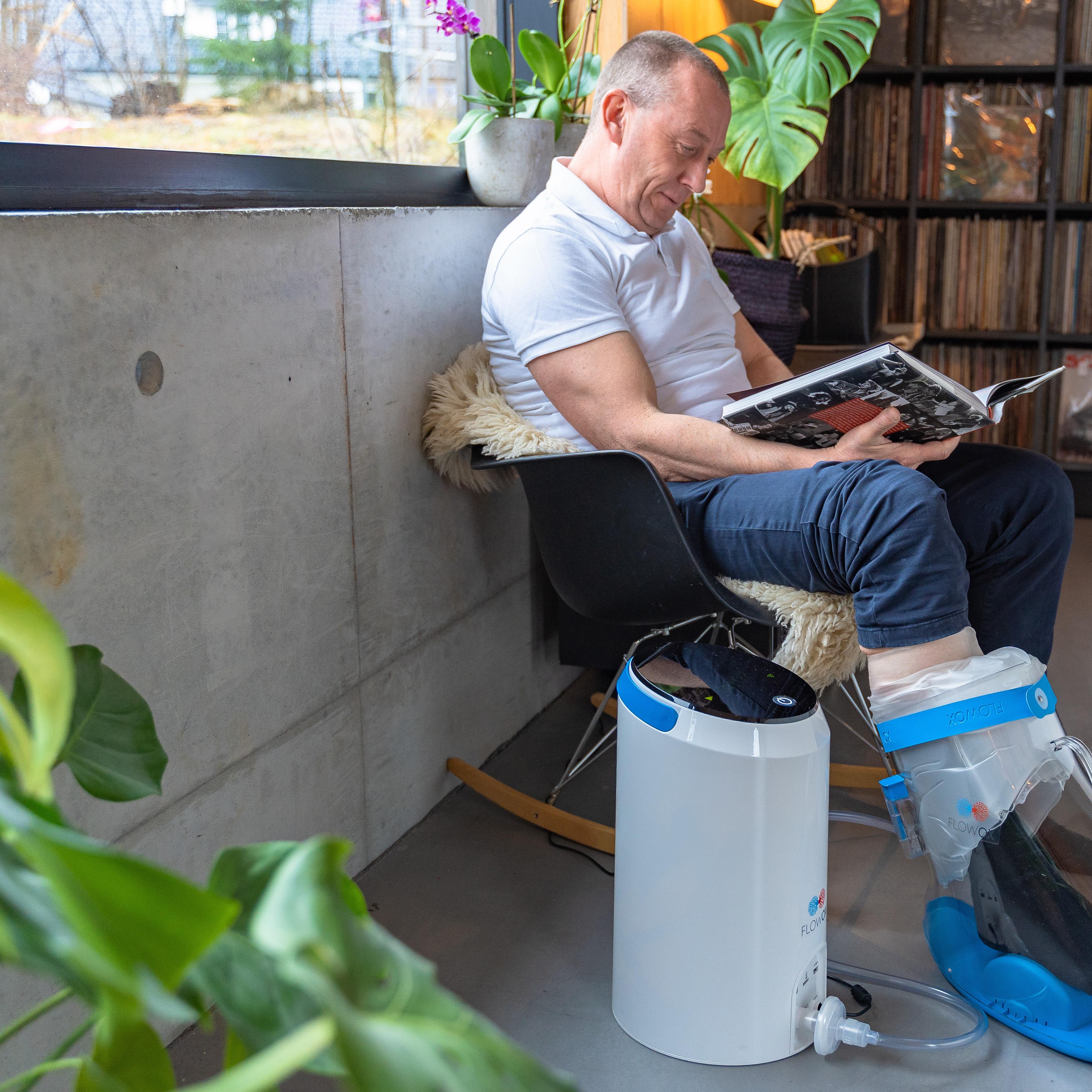
PASSIVE PHASE ACTIVE PHASE
Increased fluctuations in arterial flow
The picture of the active phase shows an increased amplitude from the baseline which indicates an increaced arterial blood flow.
The black dotted lines illustrate the measurements of the blood flow when applying intermittent negative pressure.
Flow Mediated Dilation & Shear Stress
Mechanism of Action with FlowOx™
Treatment with FlowOx™ increases shear stress, which acts as a positive stimulus on the endothelium, resulting in improved tissue perfusion.
For patients with PAD, FlowOx™ increases the capacity of the vasculature, including existing collaterals.
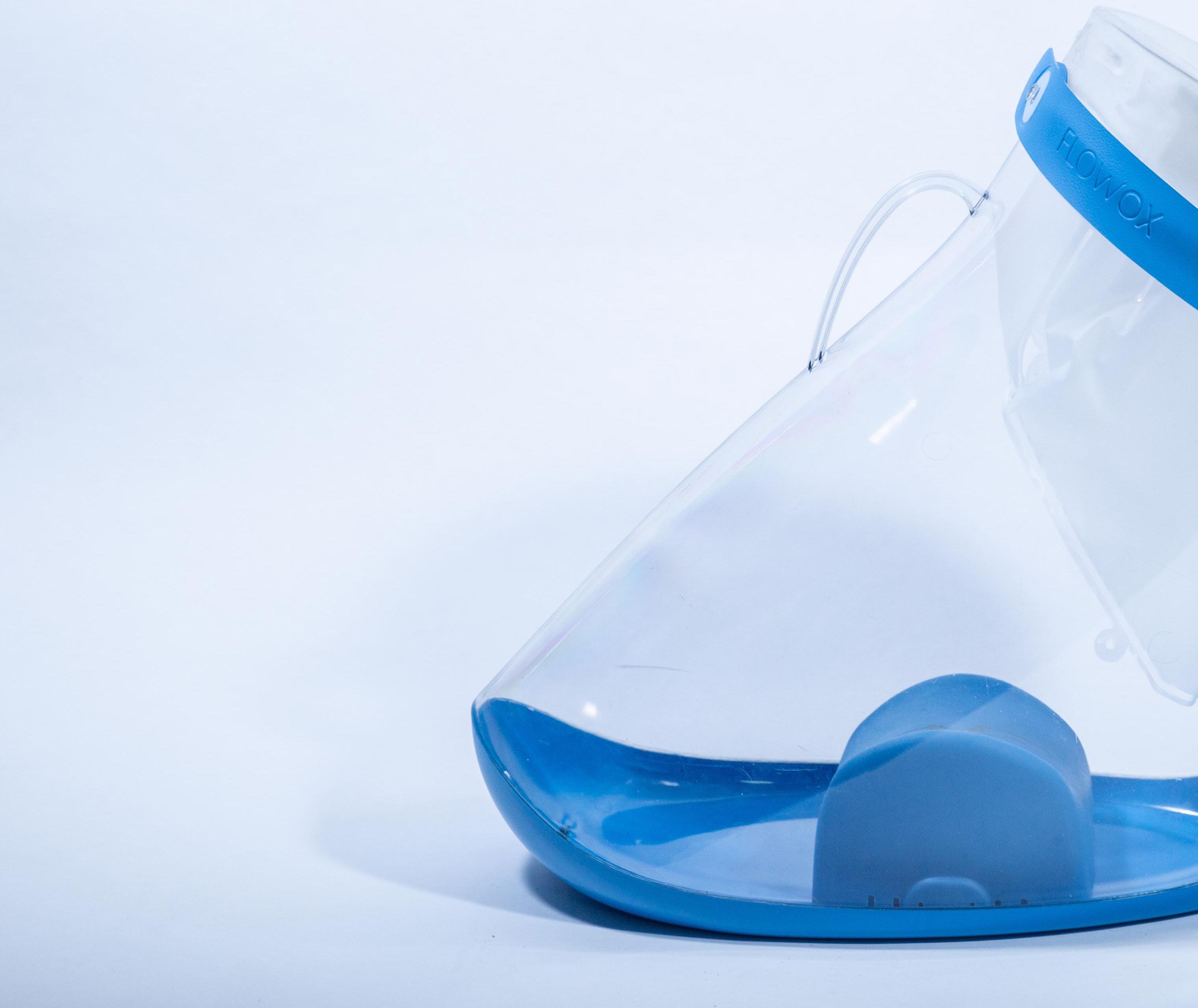
Shear Stress
The vascular endothelium is exposed to a hemodynamic stress generated by the blood flow known as the wall shear stress. Wall shear stress is defined as the force per unit area exerted on the vessel wall by the blood flow and it depends on blood viscosity and the blood flow velocity profile.
Vasodilation is the dilation, or widening, of blood vessels.
Angiogenesis is the growth of new blood vessels.
Arteriogenesis is the remodeling of existing collaterals.
Results after 12 weeks: Improved walking distance Treatment with intermittent negative pressure (INP) for intermittent claudication
Treament with intermittent negative pressure (INP) for intermittent claudication
A Randomized Controlled Trial (RCT)
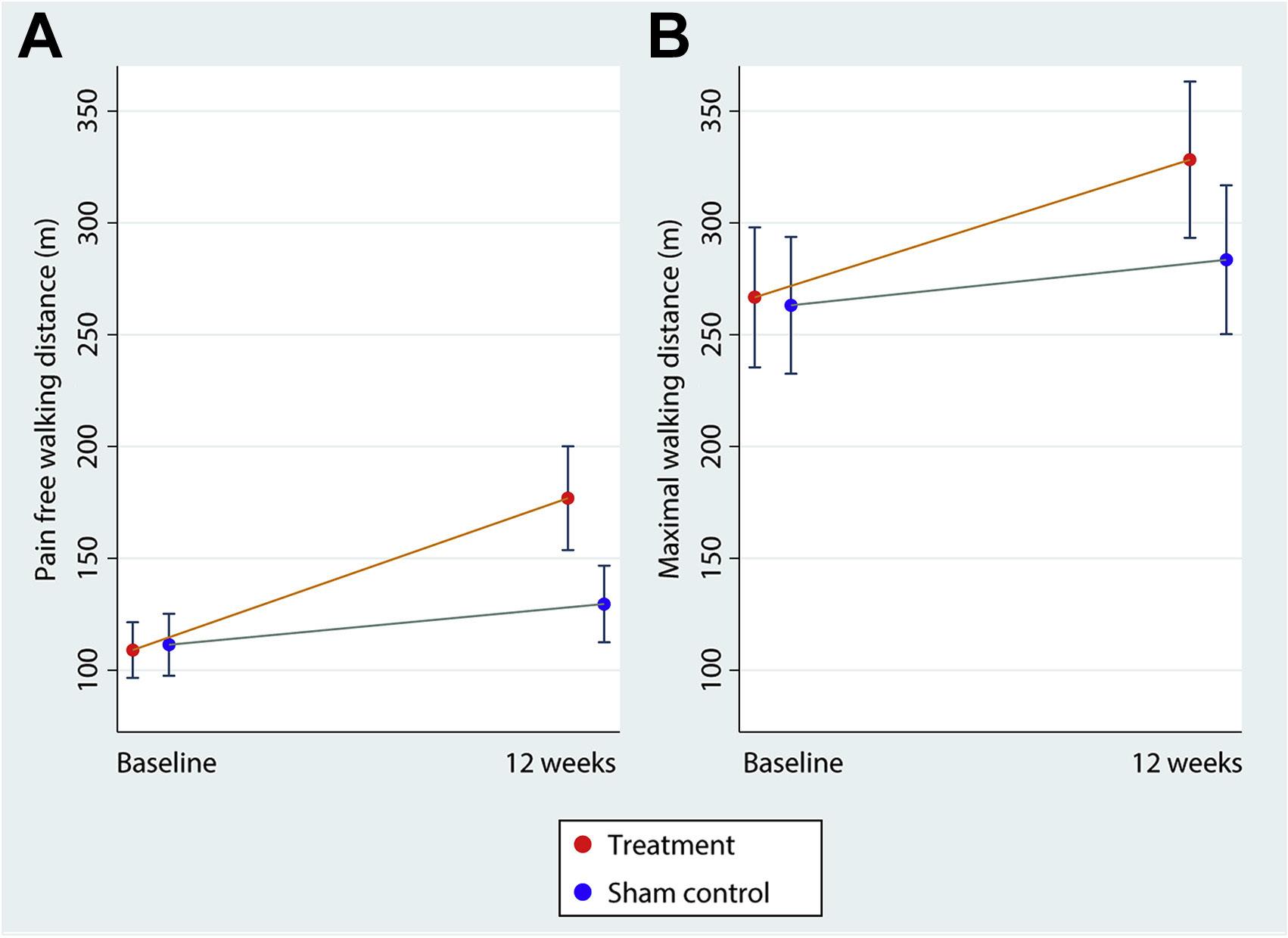
CLINICAL DATA AND EVIDENCE
The objective of this study was to investigate the effects of lower extremity intermittent negative pressure (INP) treatment for 1 hour two times daily for 12 weeks on the walking distance of patients with intermittent claudication (IC).
Enrollment and allocation
In the enrollment of the claudicant RCT, 85 patients were assessed for eligibility.
PWD = Pain-Free Walking Distance
MWD = Maximal Walking Distance
72 patients were randomized into 2 groups:
• 38 patients were allocated to -40 mmHg INP treatment
• 34 patients were allocated to -10 mmHg INP treatment.
All patients went through 12 weeks of treatment without knowing what type of group they were in.
The results of the study demonstrate that treatment with -40 mm Hg INP for one hour in the morning and one hour in the evening for 12 weeks resulted in an increase in pain-free walking distance (PWD) compared to sham treatment in patients with IC.

Pain-Free Walking Distance (PWD)
The PWD for the active treatment group showed an increase of 68 meters after 12 weeks, while the sham treatment group showed an increase of 18 meters.
Maximal Walking Distance (MWD)
The MWD for the active treatment group showed an increase of 62 meters, while the sham treatment group showed an increase of 20 meters.
Follow-up trial: Walking distance after 24 weeks
Treatment with intermittent negative pressure (INP) for intermittent claudication (IC)
Hoel H et al. Ann Vasc Surg. 2021
The Claudicant RCT Follow-Up trial conducted by Hoel H. et. al. examined the walking distance after 24 weeks of treatment.
Ten patients who received the -40 mmHg INP treatment participated in the Follow-Up trial. These results provide valuable insights into the efficacy of the FlowOx™ therapy for improving walking distance in patients with IC.
The results showed a mean increase in the Pain-Free Walking Distance (PWD) of 100 meters after 24 weeks of treatment with the FlowOx™ device (p=0.006).

Additionally, the Maximal Walking Distance (MWD) showed a mean increase of 183 meters after 24 weeks (p=0.012). 10 patients given the -40 mmHg INP treatment were enrolled in the Follow up trial.
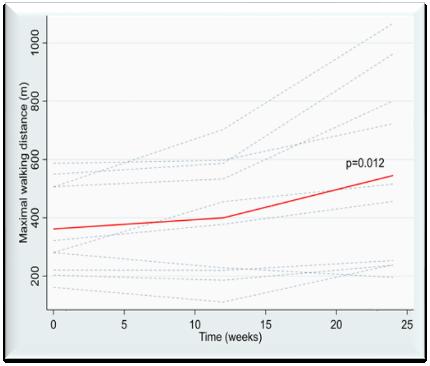
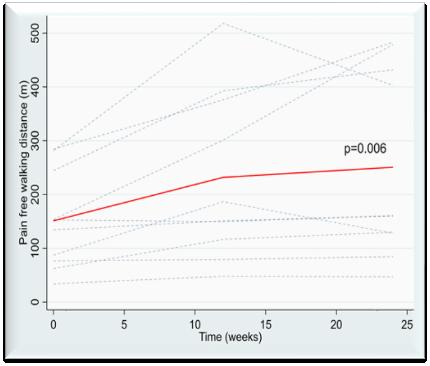
RESULTS OF FOLLOW-UP TRIAL RESULTS OF FOLLOW-UP TRIAL
100 Meter Increase
Pain-free Walking Distance
183 Meter Increase Maximal Walking Distance
Impact on Secondary Clinical endpoints
Wound Healing & Leg Ulcers
Conducting research on wound healing and foot ulcers is a very complex and difficult process due to several factors:

» Complexity of the condition
» Variability in patient populations
» Difficulty in measuring outcomes
» Limited evidence base
Impact on Secondary Clinical endpoints
Reports on using INP therapy on wounds & leg ulcers
Result
Case Report
PHYSIOLOGICAL REPORTS
The effects of intermittent negative pressure on the lower extremities´ peripheral circulation and wound healing in four patients with lower limb ischemia and hard-to-heal leg ulcers: a case report
Øyving H. Sundby1,2,3, Lars Ø. Høiseth1,4 Iacob Mathiesen3 Jørgen J, Jørgensen2,5 & Jonny Hisdal1
“In these cases, involving patients with hard-to-heal leg and foot ulcers, observed that INP therapy improved ulcer healing considerably.”
“Foot perfusion improved after completion of 8 weeks of INP-therapy.”
Despite these challenges, there have been promising results from physiological case reports that have explored the use of FlowOx™ treatment for wound healing and foot ulcers. These studies offer a glimpse into the potential benefits of this treatment and suggest the need for further research in this area.
Case Report
PHYSIOLOGICAL REPORTS
Intermittent mild negative pressure applied to the lower limb in patients with spinal cord injury and chronic lower limb ulcers: a crossover pilot study
Øyving Heiberg Sunby1,2,3, Ingebjørg Irgens2,4 Lars Ø. Høiseth1,5, Iacob Mathiesen3, Eivind Lundgaard4, Hanne Haugland6, Harald Weedon-Fekjær7, Jon O. Sunhagen8, Gunnar Sandbæk2,9 Jonny Hisdal1
Result
“INP therapy can be used as a home-based treatment for patients with SCI and chronic lower U limb ulcers.”
Published Papers
On FlowOx™ and INP
1. Application of intermittent negative pressure on the lower extremity and its effect on macro- and microcirculation in the foot of healthy volunteers, Sundby et al; Physiol Rep, 4 (17), 2016
2. The acute effects of different levels of intermittent negative pressure on peripheral circulation in patients with peripheral artery disease; Hoel et al.; Physiol Rep, 7 (20), 2019
3. The acute effects of lower limb intermittent negative pressure on foot macro- and microcirculation in patients with peripheral arterial disease; Sundby et al.; PLoS ONE 12(6): e0179001.
4. Intermittent negative pressure applied to the lower limb increases foot macrocirculatory and microcirculatory blood flow pulsatility in people with spinal cord injury; Sundby et al.; Spinal Cord https://doi.org/10.1038/s41393017-0049-8
5. Fluctuation in shear rate, with unaltered mean shear rate, improves brachial artery flow-mediated dilation in healthy, young men; Holder et al.; J Appl Physiol 126: 1687–1693, 2019
6. A randomized controlled trial of treatment with intermittent negative pressure for intermittent claudication, Hoel et al.; Journal of Vascular Surgery, vol. 73, no. 5
7. Lower Extremity Intermittent Negative Pressure for Intermittent Claudication. Follow-Up after 24 Weeks of Treatment, Hoel et al.; Annals of Vascular Surgery
8. The effects of intermittent negative pressure on the lower extremities’ peripheral circulation and wound healing in four patients with lower limb ischemia and hard-to-heal leg ulcers: a case report; Sundby et al.; Physiol Rep, 4 (20), 2016
9. Intermittent mild negative pressure applied to the lower limb in patients with spinal cord injury and chronic lower limb ulcers: a crossover pilot study; Sundby et al.; Spinal Cord (2018) 56:372–381
10. Economic model to examine the cost- effectiveness of FlowOx™ home therapy compared to standard care in patients with peripheral artery disease; Ezeofor et al; PLoS ONE 16(1): e0244851
11. The FlowOx™ device for the treatment of peripheral artery disease: current status and future prospects; Hoel, Hisdal; Expert Review of Medical Devices, 18:3, 217-220
12. Patient and Clinician experiences and opinions of the use of a novel home use medical device in the treatment of peripheral vascular disease - a qualitative study; Sedgwick et al.; https://doi.org/10.21203/rs.3.rs-290345/v1
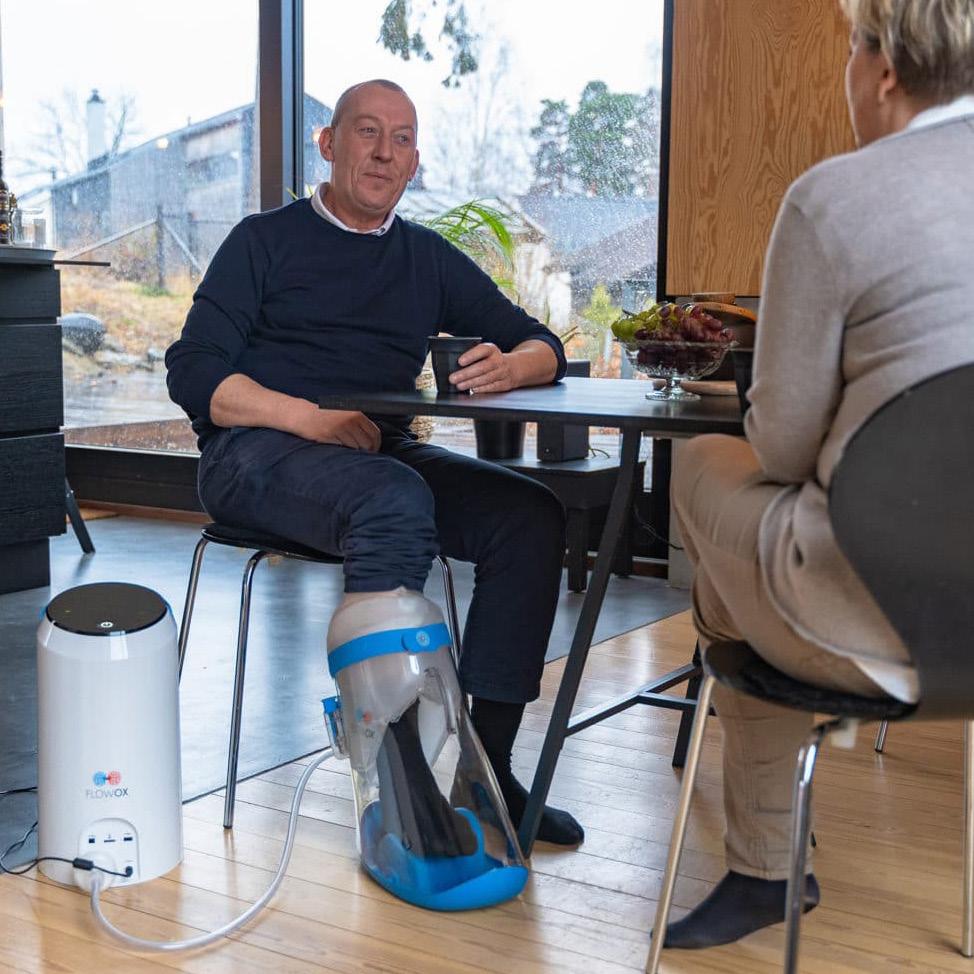
13. Effects of intermittent negative pressure treatment on circulating vascular biomarkers in patients with intermittent claudication; Hoel et al.; Vascular Medicine 1–8 2021
14. The Effect of 12-Week Treatment with Intermittent Negative Pressure on Blood Flow Velocity and Flowmotion, Measured with a Novel Doppler Device (Earlybird). Secondary Outcomes from a Randomized Sham-Controlled Trial in Patients with Peripheral Arterial Disease Mulder Pettersen et al.; Annals of Vascular Surgery, April 22, 2022




